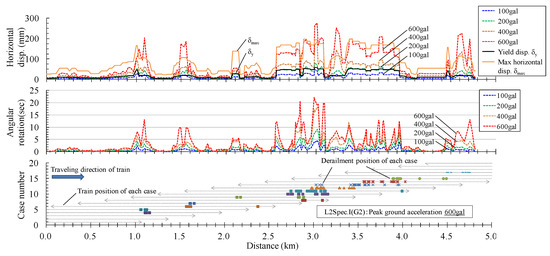Abstract
In this study, using the analysis program DIASTARS III that is able to take into account the dynamic interaction between railway vehicles and railway structures, we conducted seismic train-running analysis on a model line that is about 4.8 km long. And we identified the relative weak structures of seismic train-running safety in the model line.
1. Introduction
In recent years, a variety of studies on train-running safety during an earthquake have been conducted in Japan [1,2]. However, these studies have not identified specific structures among the group that could be critical in relation to the occurrence of a derailment. In this study, we examine the simulation of train-running during an earthquake in a model line. And then, relative weak structures that could affect train-running safety during an earthquake are clarified.
2. Methodology
A program called DIASTARS III, which analyzes the dynamic interaction between railway vehicles and railway structures, is used in the numerical analysis [2]. In this program, Vehicles are modeled as multi-body and structures are modeled by finite element. Regarding the vehicles for this study, 12-car train (300 m in length) is used and the running speed is set to 320 km/h. Figure 1 shows the specifications of the entire model line. In this study, the analysis model line based on a structural database is created. The length is 4.8 km. Each block of the structures is modeled as a rigid beam element. The mass and the non-linear property of each structure are determined based on the design calculation for actual structure. L2 spectrum I of ocean-trench type, which is one of the design earthquakes, is used for input earthquake ground motion [3]. Since the vehicle response had strong non-linearity, the seismic peak ground acceleration (PGA) is gradually and linearly increased. The train is run for a total of 20 cases, in each of which the start point is shifted by 300m, to cover the entire line.

Figure 1.
Specifications of entire model line.
3. Result and Discussion
Figure 2 shows the maximum response of each structure and the derailment position of the train. Regarding the horizontal displacement and the angular rotation, almost all of the structures start to yield at around PGA of 200 gal and the maximum displacements increase substantially with higher PGA. The rotation angles are greater where the equivalent natural period differs widely between the structures that yielded and the adjoining structures. In addition, the result of the derailment position indicated that derailment occurred where the angular rotation is greater, suggesting that differential displacement (angular rotation) is more dominant than vibration displacement (horizontal displacement) in determining the train-running safety during the earthquake.

Figure 2.
Maximum response of each structure and derailment position of the train.
4. Conclusions
We conducted seismic train-running analysis on a model line with about 4.8 km long. This study clarifies that (1) almost all of the structures in the model line start to yield at around PGA of 200 gal and the maximum displacements increase substantially with higher PGA; (2) the seismic train-running safety is more likely to be affected by differential displacement (angular rotation) than vibration displacement (horizontal displacement) in the model line.
Acknowledgments
The first author would like to thank Railway Technical Research Institute (RTRI) for the financial support at the University of Birmingham. The authors are also sincerely grateful to the European Commission for the financial sponsorship of the H2020-RISE Project No. 691135 “RISEN: Rail Infrastructure Systems Engineering Network”, which enables a global research network that tackles the grand challenge of railway infrastructure resilience and advanced sensing in extreme environments (www.risen2rail.eu).
References
- Railway Technical Research Institute. Design Standards for Railway Structures and Commentary (for Displacement Limits); Maruzen: Tokyo, Japan, 2012. [Google Scholar]
- Sogabe, M.; Goto, K.; Tokunga, M.; Asanuma, K. Risk assessment method for train-running safety during seismicity on railway line. In Proceedings of the 9th World Congress on Railway Research (WCRR 2011), Lille, France, 22–26 May 2011. [Google Scholar]
- Railway Technical Research Institute. Design Standards for Railway Structures and Commentary (for Seismic Design); Maruzen: Tokyo, Japan, 1999. [Google Scholar]
Publisher’s Note: MDPI stays neutral with regard to jurisdictional claims in published maps and institutional affiliations. |
© 2018 by the authors. Licensee MDPI, Basel, Switzerland. This article is an open access article distributed under the terms and conditions of the Creative Commons Attribution (CC BY) license (https://creativecommons.org/licenses/by/4.0/).